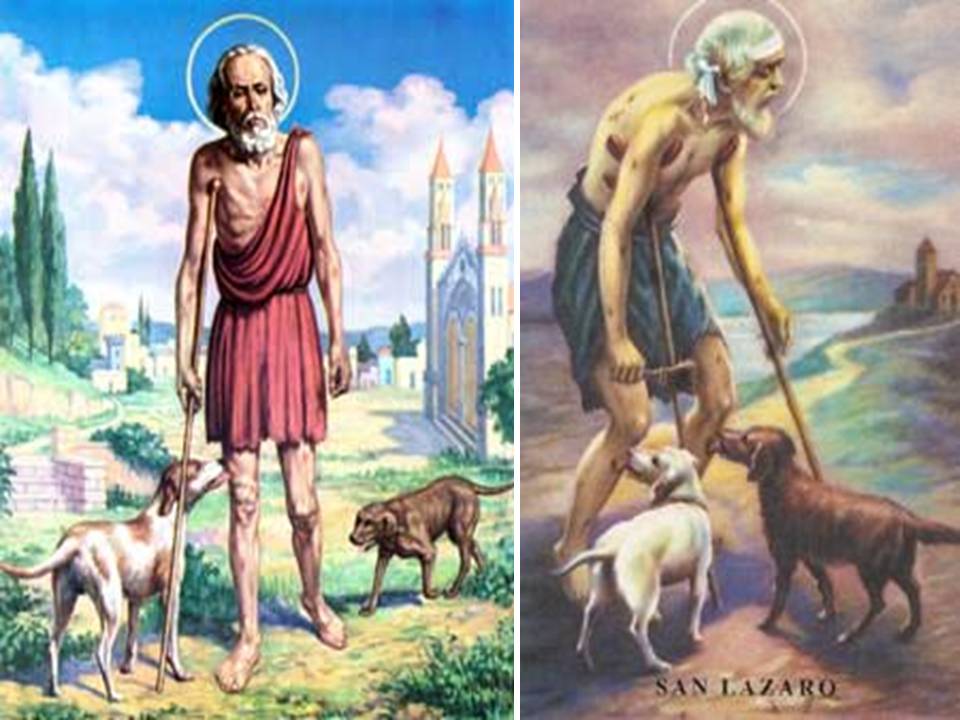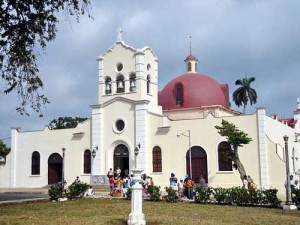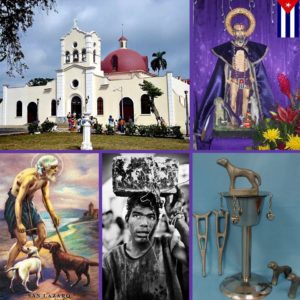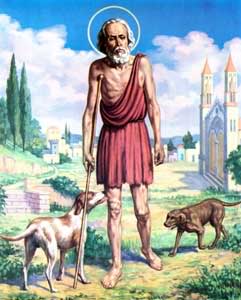SAN LAZARO, THE ONE WITH THE CRUTCHES AND DOGS.

In Cuba after the Virgin de la Caridad del Cobre, San Lazaro is the most revered saint, usually linked to Santeria. It has a shrine on the outskirts of Havana. The pilgrimage is multitudinous in December, a human wave of more than 10 kilometeres long. Throughout the day and even at night … because at 12 in the night all want to be before the saint, which is impossible, of course. From time before 17 December, carrying promises set off his knees, crawled, carrying stones, chains, iron on his back legs.
San Lazaro is a saint very invoked by the Cubans. This is the Cuban of the santeria or is Lazarus the brother of Martha and Mary in the Gospels?
In San Lazaro is given the confluence of two different characters: Lazarus, brother of St. Mary of Bethany (not today identified with Mary Magdalene) and Santa Marta, were friends of Jesus and invited him to his home in Bethany, near Jerusalem, where he was loved and welcomed. Signal intimacy with Christ is the fact as Jesus, even going to resuscitate after Lazarus died, cried when contemplating the grief of Mary and Martha. One of the greatest miracles of Christ was precisely the bringing back to life (which was no resurrection) Lazarus. So far, the only accurate than can be said of this character friend of Jesus and Lazarus, the poor beggar of the parables of Jesus. We see them separately:
St. Lazarus, the one with the sores, crutches and dogs, comes from a passage in the Gospels.
According to the Gospel of Luke, Jesus often spoke in parables to the people, once said to the Pharisees: “There was a rich man who was clothed in purple and fine linen, and was sumptuously every day. Had a certain beggar named Lazarus, which was laid at his gate, desiring to be fed with the crumbs which fall from their table, full of sores, and even the dogs came and licked his arrive.
It happened that the beggar died, and was carried by the angels into Abraham’s bosom: the rich man also died and was buried.
And in hell he lift up his eyes, being in torments, and seeth Abraham afar off, and Lazarus in his bosom. Then he cried and said, Father Abraham, have mercy on me, and send Lazarus to dip the tip of his finger in water and cool my tongue, for I am tormented in this flame.
But Abraham said, Son, remember that you received your good in your life, and likewise Lazarus evil things: but now he is comforted, and thou art tormented. And besides all this, a great chasm has been made between us and you, that they which would pass from hence to you can not, and from there to here. ”
However, the Catholic religion ever sanctified the biblical parable of the beggar. For this the only saint of that name is San Lazaro Obispo, which always appears in the images without sores, wearing a miter and covered with a layer under its hierarchy.
What then is the cause of widespread devotion to our country of the figure of the beggar lacerated?
You have to tender to find that blacks equivalence Lucumis chased in their African gods with Christian images. For them evangelical character was Babayú-Aye, the “orisha” to cure the sick and protect the poor. And with this character his image placed on the altars they built in their councils and popularized. Babayú-Aye in syncretism is compared to San Lazaro (December 17).
The veneration of St. Lazarus “on crutches” still exists in the church (in San Nicolas de Bilbao is venerated a great height). The St. Nicholas Church located in the city of Bilbao (Biscay, Basque Country, Spain) is a baroque Catholic church opened in 1756. Stained glass, frescoes, carvings, reverence us about this character, tied with San Roque and the leper hospitals because leprosy suffered (by tradition, even if the Gospel does not say).
Agencies/Wiki/Various/Internet Photos/Arnoldo Varona/ TheCubanHistory.com
THE CUBAN HISTORY, HOLLYWOOD.
FOLLOW US ON TWITTER AND FACEBOOK. THECUBANHISTORY.COM
![]() SAN LÁZARO, EL DE LAS MULETAS Y LOS PERROS
SAN LÁZARO, EL DE LAS MULETAS Y LOS PERROS
En Cuba después de la Virgen de la Caridad del Cobre, San Lázaro es el santo más venerado, casi siempre ligado a la santería. Tiene un santuario a las afueras de la Habana. La peregrinación de diciembre es multitudinaria, una marea humana de mas de 10 kilomentros de largo. Durante todo el día y más aún de noche… porque a las 12 de la noche todos quieren estar ante el santo, cosa imposible, evidentemente. Desde tiempo antes del 17 de diciembre, los que llevan promesas se ponen en camino de rodillas, a rastras, llevando piedras, cadenas, piernas de hierro a cuestas.
San Lázaro es un santo muy invocado por los cubanos. Se trata de la santeria cubana o es Lázaro el hermano de Marta y Maria en los evangelios?
En San Lázaro se da la confluencia de dos personajes distintos: Lázaro, hermano de Santa María de Betania (ya hoy no identificada con María Magdalena) y Santa Marta, eran amigos de Jesús y le invitaban a su casa en Betania, cerca de Jerusalén, donde era amado y acogido. Señal de su intimidad con Cristo es el hecho de como Jesús, aún yendo a resucitarle, luego de morir Lázaro, lloró, al contemplar el duelo de María y Marta. Uno de los milagros más grandes de Cristo fue, precisamente el traer de nuevo a la vida (que no fue resurrección) a Lázaro. Hasta aquí, lo único certero que se puede afirmar de este personaje amigo de Jesús y Lázaro, el pobre mendigo de las parabolas de Jesus. Los vemos por separado:
San Lázaro, el de las llagas, las muletas y los perros, tiene su origen en un pasaje de los Evangelios.
Según el Evangelio de San Lucas, Jesús, que solía hablar en parábolas a las gentes, dijo un día a los fariseos: “Había un hombre rico, que se vestía de púrpura y de lino fino, y hacía cada día banquete con esplendidez. Había también un mendigo llamado Lázaro, el cual estaba echado a la puerta de él, deseando hartarse de las migajas que cayeran de su mesa, lleno de llagas, y aun los perros venían y le lamían las llegas.
Y aconteció que murió el mendigo, y fue llevado por los ángeles al seno de Abraham: y murió también el rico, y fue sepultado.
Y en el infierno alzó sus ojos, estando en los tormentos, y vio a Abraham de lejos, y a Lázaro en su seno. Entonces él, dando voces, dijo: Padre Abraham, ten misericordia de mi, y envía a Lázaro que moje la punta de su dedo en agua, y refresque mi lengua; porque soy atormentado en esta llama.
Y díjole Abraham: Hijo, acuérdate que recibiste tus bienes en tu vida, y Lázaro también males; mas ahora este es consolado aquí, y tú atormentado. Y además de todo esto, una grande sima está constituida entre nosotros y vosotros, que los que quisieren pasar de aquí a vosotros, no pueden, ni de allá pasar acá”.
Sin embargo, la religión católica jamás santificó al mendigo de la parábola bíblica. Para ésta el único santo de ese nombre es San Lázaro Obispo, el cual aparece siempre en las imágenes sin llagas, tocado con una mitra y cubierto con una capa conforme a su jerarquía eclesiástica.
¿Cuál es la causa entonces de devoción tan extendida en nuestro país de la figura del mendigo lacerado?
Hay que irla a buscar a la equivalencia que los negros lucumíes persiguieron en sus dioses africanos con las imágenes cristianas. Para ellos personaje evangélico era Babayú-Aye, el “orisha” que cura a enfermos y protegía a los pobres. Y con este carácter colocaron su imagen en los altares que construían en sus cabildos y lo popularizaron. Babayú-Aye en el sincretismo se le compara con San Lázaro (17 de Diciembre).
La veneración a San Lázaro “de las muletas” existe aún en la iglesia (en San Nicolás de Bilbao se venera una estupenda talla). La iglesia de San Nicolás sita en la ciudad de Bilbao (Vizcaya, País Vasco, España) es un templo católico de estilo barroco inaugurado en 1756 y proyectado por el arquitecto Azpeitiarra Ignacio Ibero. Vitrales, frescos, tallas, nos hablan de la veneración a este personaje, ligada junto a San Roque a los leprosorios y hospitales, pues padeció la lepra (por tradición, aun cuando el Evangelio no lo dice).
Agencies/Wiki/Various/Internet Photos/Arnoldo Varona/ TheCubanHistory.com
THE CUBAN HISTORY, HOLLYWOOD.








